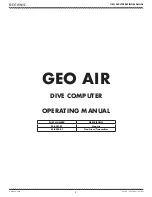
MI 3290 Earth Analyser
Tests and Measurements
82
Notes:
Automatic compensation of inductive components.
Explanation: The impedance Ze is measured and the value of the earth resistance Re
is then derivated out of that impedance.
to
w
er
1
R
e
X
L1
+
R
L1
R
L
Igw
Rp
Rc
H
S
E
The influence of the
OHGW is eliminated
by using a high
frequency (25 kHz)
test signal.
X
L2
+
R
L2
R
L
to
w
er
2
Xl
Re
Xl
Ze
φ
Xc
Ie
Ih
Overhead grounding wire
(OHGW) of tower 1 and 2.
Figure 11.28: Compensation in HF 25 kHz method
Typical ground wire inductance in power lines
200 µH – 800 µH.
Test can be started from the HF-Earth Resistance (25 kHz) measurement window. Before
carrying out a test the following parameters (SER/PAR Model, Distance and Limit (Re)) can
be edited.
Figure 11.29: HF-Earth Resistance (25 kHz) measurement menu
Test parameters for HF-Earth Resistance (25 kHz):
SER/PAR Model
Set desired model: [Series or Parallel]
Distance (r)
Distance between E and S probe (user defined).
Distance (R)
Distance between E and auxiliary earth rod H (user defined).
Limit (Re)
Limit value selection [
OFF, 1 Ω – 100 Ω]
HF-Earth Resistance (25 kHz) Measurement procedure:
Select the HF-Earth Resistance (25 kHz) Measurement function.
Set a test parameters (model, distance, limit).
Connect the test leads to the instrument and to the test object.
Use shielded cable (H) with guard connection.
Press the Run key to start the measurement.
Wait until the test result is displayed on the screen.
Save results (optional).
Figure 11.30: Example of HF-Earth Resistance (25 kHz) measurement result
















































